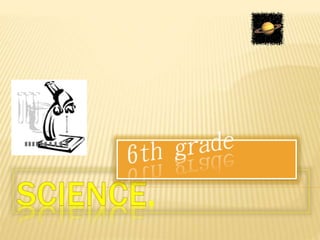
Science 6º 27 de enero (2)
- 1. .
- 6. INDEX * Vocabulary. * Reading Comprehension. * Written Composition. 1.- Definition of Ecosystem. 2.- Types of Ecosystems. 2.1.- Aquatic Ecosystems- 2.2.- Terrestrial Ecosystems. 2.3.- Mixed Ecosystems.
- 7. 3.-The Elements of an ecosystem 3.1.- Living things in an ecosystem- 3.1.1.- What are species. 3.1.2.- Adaptations of living things. 3.2.- The habitat. 3.3.- Interactions in the ecosystems. 3.3.1.- Food chains and Food webs
- 8. 4.- Human activity and Ecosystems. 4.1.- Alteration of Ecosystems. 4.2.- Problems caused. 4.3.- Ways of protecting the planet.
- 9. THE WORD ECOSYSTEM It comes from ECO(home in Greek) ECOLOGY is the study of the relationship between living things and their environment. And SYSTE MA system is made up of parts that form a whole.
- 10. 1.-DEFINITION OF ECOSYSTEM An ecosystem is a community of living things and non-living things that interact in the same place.
- 11. *Living things like animals, plants and microorganisms. *And non living things aspects of the environment like water, light, soil and temperature.
- 12. 2.- TYPES OF ECOSYSTEMS 2.1. - AQUATIC ECOSYSTEMS Aquatic ecosystems are found in water. Rivers, lakes, seas and oceans contain aquatic ecosystems. There are two types: Fresh water or salt water ecosystems.
- 13. 2.2.- TERRESTRIAL ECOSYSTEMS Terrestrial ecosystems are found on land. Deserts, forests, tundra and grasslands are the main terrestrial ecosystems.
- 14. 2.3. - MIXED ECOSYSTEMS. These ecosystems combine elements from aquatic and terrestrial ecosystems, like ponds, swamps and beaches...
- 15. TRUE OR FALSE *Tundra Ecosystems are in the Artic Circle. *The living things that you can find in a Pond Ecosystem depend on the type of shore. *There is Little biodiversity in the Beaches Ecosystems because there is too much salt water. *We can find the same aquatic plants or animals in all Oceans. *There are more evergreen trees than deciduous trees in the Forest Ecosystems. *Lakes Ecosystems contain water all year. *The species that inhabited a River Ecosystem depend on the water temperature. *In Desert Ecosystems there is more evaporation than rainfall. *In Grassland Ecosystems there is a lot of rainfall.
- 16. 3. The elements of an ecosystem. It consists of living things ,a habitat or physical environment and the relationship or interaction between living things.
- 17. 3.1.1 Living things in a ecosystem.In an ecosystem there are many different living things, such as ___plants _ and __animals_. Why are some butterflies different from each other? Because they are members of two different ___species______. SPECIES consist of a ____group_______ of organisms that reproduce among themselves. Members of the same species possess ______similar __ characteristics. They often appear and ______behave_______ similarly. A group of the same area is called a _____population______ All these different populations of living things make up a ___community_____
- 18. Living things in each ecosystem have certain characteristics called adaptations, which permit them to survive in that ecosystem.
- 19. How have these animals these adapted to their environment?
- 20. POLAR BEAR- LIVES IN THE ARTIC ECOSYSTEM. Has white fur for camouflage. Has a layer of fat under fur for extra insulation. Has sharp teeth and claws to catch and eat prey. How is a Polar bear suited to its ecosystem?
- 21. CAMEL- LIVES IN THE DESERT Can close nostrils to keep out sand. Has long eyelashes to keep out sand. Can store fat in hump and go for long periods without water. How is a camel suited to its ecosystem?
- 22. PENGUIN- LIVES IN THE ARTIC Has thick layer of fat to keep warm. Produces oil to keep feathers waterproof. Stream lined body for swimming. How is a penguin suited to its ecosystem?
- 23. CACTUS- LIVES THERE. Can survive a long time without water. Has sharp spikes for protection. Has long roots to collect water. How is a cactus suited to its ecosystem?
- 24. ACTIVITY FOR THE NOTEBOOK. WHAT ECOSYSTEM DO THESE LIVING THINGS INHABIT? HOW IS A Penguin, Camel, Cactus, Polar bear SUITED TO ITS ENVIRONMENT?
- 25. HOW IS A POLAR BEAR SUITED TO ITS ENVIRONMENT? It lives in an Artic Ecosystem. It has sharp teeth and claws, to catch and eat preys
- 26. 3.2 HABITATS. The place where an animal or living thing lives is called its habitat. An animal lives when it can find food, water and shelter.
- 27. 3.2.1 CHARACTERISTICS HABITATS. Oceans- cold, salt water, many predators. Artic- Very cold, snow and ice, little shelter. Rainforest.- Very hot , humidity, many plants and trees.
- 28. 3.2.CHARACTERISTICS HABITATS. Woodland- can be cold in winter, many plants and trees. Meadow- little shelter, lot of grass to eat. Mountains- very cold higher up, little shelter
- 29. 3.2.CHARACTERISTICS HABITATS. Swamp -Damp, marshy with many different plants. Desert – very dry,hot in the day, cold at night, little shelter. Pond/lake.-Sheltered water is calm, many plants.
- 31. CHARACTERISTICS rs Ocean – cold, salt water, many predators Rain forest – very hot, damp and many plants & trees Swamp –Marsh damp, marshy, with many different plants Artic – very cold, snow and ice, little shelter
- 32. Meadow – little shelter, lots of grass to eat Mountains – very cold higher up, little shelter Woodland – can be cold in winter, many plants and trees
- 33. Pond/lake – sheltered water is calm, many places to hide
- 34. 3.2..1 HABITATS AND LIVING THINGS. SEA/ DEEP WATER FOREST/ WOOD GARDEN URBAN (TOWN) DESERT SHARK OAK TREE LADYBIRD PIGEON CAMEL LOBSTER OWL FLOWER RAT RAT SEAWEED DEER SNAIL WOODLO USE SQUIRREL WORM DANDELIO N
